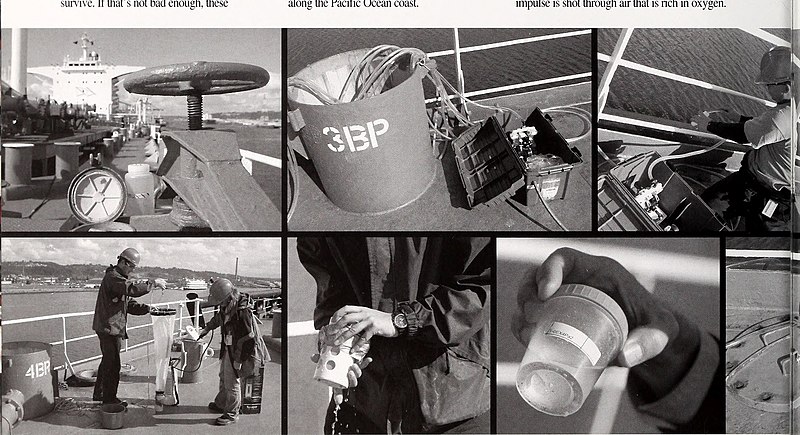File:Coast watch (1979) (20472997640).jpg

Original file (2,940 × 1,598 pixels, file size: 1.37 MB, MIME type: image/jpeg)
Captions
Captions
Summary[edit]
| DescriptionCoast watch (1979) (20472997640).jpg |
English: Left to right, top to bottom: The deck of the Tonsina — note ballast tanks along the sides and bottom of the tanker. Ballast water-sampling equipment at the ready. Filling a sample bottle with water pumped from one of the Tonsinas 12 ballast tanks. Fine-meshed zooplankton nets capture ballast water organisms. Zooplankton samples are concentrated in the plankton net and placed in a plastic container. Title: Coast watch |
| Date | |
| Source |
https://www.flickr.com/photos/internetarchivebookimages/20472997640/
|
| Author | UNC Sea Grant College Program |
| Permission (Reusing this file) |
At the time of upload, the image license was automatically confirmed using the Flickr API. For more information see Flickr API detail. |
| Flickr tags InfoField |
|
| Flickr posted date InfoField | 17 August 2015 |
Licensing[edit]
This image was taken from Flickr's The Commons. The uploading organization may have various reasons for determining that no known copyright restrictions exist, such as: No known copyright restrictionsNo restrictionshttps://www.flickr.com/commons/usage/false
More information can be found at https://flickr.com/commons/usage/. Please add additional copyright tags to this image if more specific information about copyright status can be determined. See Commons:Licensing for more information. |
| This image was originally posted to Flickr by Internet Archive Book Images at https://flickr.com/photos/126377022@N07/20472997640. It was reviewed on 18 August 2015 by FlickreviewR and was confirmed to be licensed under the terms of the No known copyright restrictions. |
18 August 2015
File history
Click on a date/time to view the file as it appeared at that time.
| Date/Time | Thumbnail | Dimensions | User | Comment | |
|---|---|---|---|---|---|
| current | 19:17, 18 August 2015 |  | 2,940 × 1,598 (1.37 MB) | Fæ (talk | contribs) | == {{int:filedesc}} == {{information |description={{en|1=<br> '''Title''': Coast watch<br> '''Identifier''': coastwatch00uncs_16 ([https://commons.wikimedia.org/w/index.php?title=Special%3ASearch&profile=default&fulltext=Search&search=insource%3A%2Fcoa... |
You cannot overwrite this file.
File usage on Commons
There are no pages that use this file.